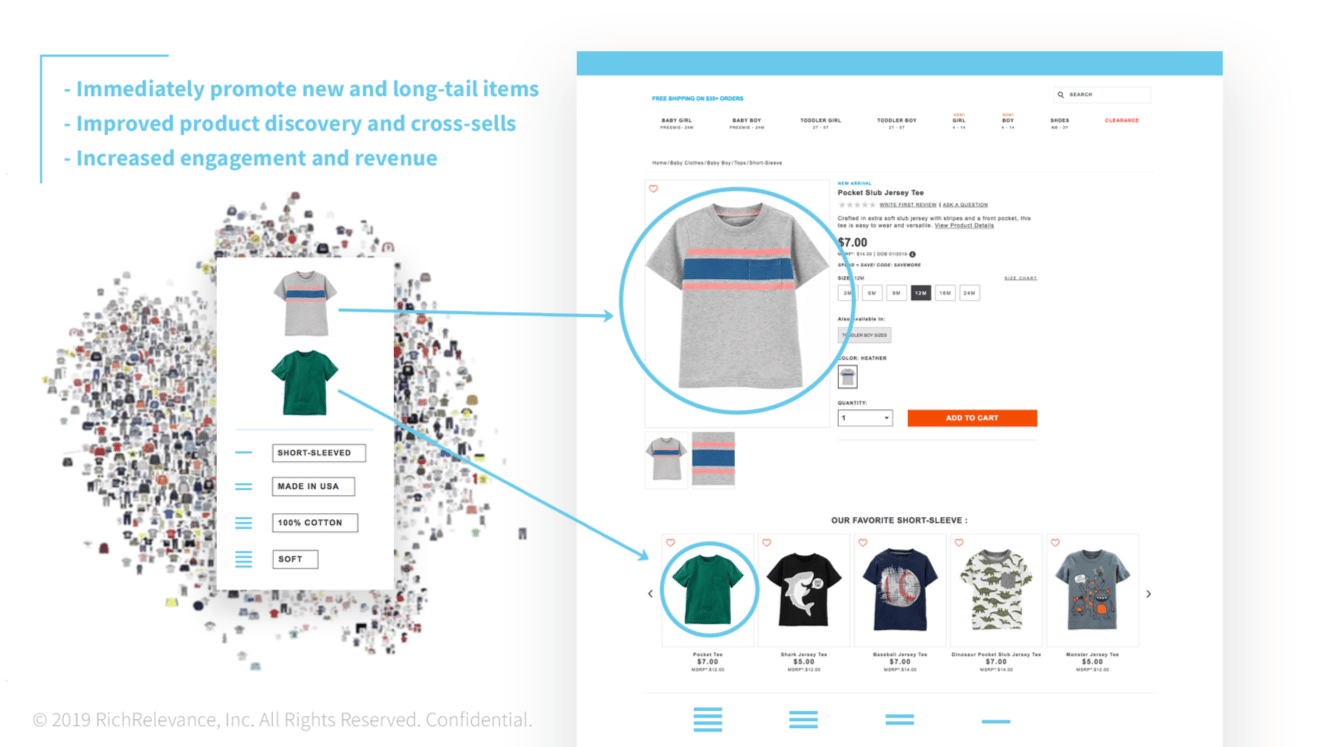How to Personalize without Behavioral Data using NLP
Personalization traditionally works best when you have tons of behavioral data for each product. But how do you personalize for new products or ones that are considered “long-tail”? How do you ensure that this inventory is immediately visible and recommended to your customers? Well, you couldn’t until recently .. not without NLP.
Let’s illustrate this with an example. Imagine that you are an apparel company based in the US. Your business is seasonal with a lot of sales that is back loaded towards the second half of the year – the holiday season.
During the holiday season, you get fresh, new inventory – tens of thousands of new SKUs – that are ready to get marketed and sold. And time is of the essence.
Traditional approaches would be to create manual merchandising rules to boost the new arrivals. And more rules when newer collections arrive. And more rules… you get the picture. The addition of rules as a way to manage your business has some serious long term drawbacks:
- one, you need to remember to turn off the rules otherwise they have unintended consequences of burying the relevant results
- two, rules benefit the merchant and not the customer. Customers can only take so much of irrelevant results before they bail
- three, the entire purpose of AI is to eliminate and simplify rules; continuing to manually merchandise is like insisting on driving on an empty freeway without cruise control – it’s possible, but tiring!
Personalization solutions in the market today are good about solving the problem when there is sufficient “learning” data. As customers continue to interact with the promotions and manual rules, the solution gets better and better over time in ensuring the right product recommendations for the given context of the shopper – whether they are online, mobile, email or more.
The key dependency here is of course time, that we don’t have enough of during crunch time. And it requires a ton of additional data and attributes that is accessible by the merchandising tool in order to create the rules – which use up precious IT time and dollars that can be put to more productive uses elsewhere.
How much is it worth to this business if there was a way to accelerate the relevancy of the new collections, and promote new products (and long tail products too that are similar as in, both have no behavioral data) AND keep the relevance for every given customer? And oh, do all of this in real-time?
Enter NLP, or natural language processing.
Most people may be familiar with NLP in the context of search. But there is usage of this technology in personalization that is way cooler. In the beginning, NLP drew heavily from Linguistics and Logic. Over time, it has been replaced by lots of data, and recently, deep learning AI.
NLP ingests text data: all of the rich feature characteristics (descriptions, styles, ratings & reviews, etc.) associated with your products. It is then used to create new data science models that have a product graph, which is a techy way to saying that all related products are linked together in a tapestry. See below.

Why is this important?
Because the Xen AI engine is already aware of these connections between products, thanks to NLP “strategies”, its possible for the engine to very quickly recommend related products even without behavioral data! In addition, it can also re-rank products in real-time within the session of the customer.
This is a game-changer for retailers/brands that regularly introduce or quickly cycle through new styles or seasonal catalogs, making it possible to personalize and expose shoppers to relevant products through cross-sell offers from the start, as well as increase the relevancy of your recommendations as they move through the funnel.
What is the limitation of this approach?
NLP strategies are specific to the use cases of new and long-tail products. As behavioral models continue to learn from NLP, they will soon overtake the NLP performance overall. This is logical if you think about it. The goal of NLP is to expose customers to new products without behavioral data, and as behavioral data grows, the Xen AI engine gets more confidence in the more traditional strategies.
So NLP not only helps initially, it also accelerates the learning of traditional personalization strategies. Hence, it is always to be used in conjunction with the existing strategies – like Tom and Huck.
What about the results?
- Customer A has seen $700K total attributable sales for the last 30 days
- Customer B has seen $2.99M total attributable sales for the last 30 days (39.1M in total sales)
- Customer C has seen $1.45M total attributable sales for the last 30 days
- Customer D has seen 3.22M total attributable sales for the last 30 days (28.6M in total sales)
Our data science team continues to tweak and tune these results. Remember, this is cutting edge science and we are the first to bring this to market in a practical scale that impacts real revenues.
Interested in how NLP can help your business? Let us know.


